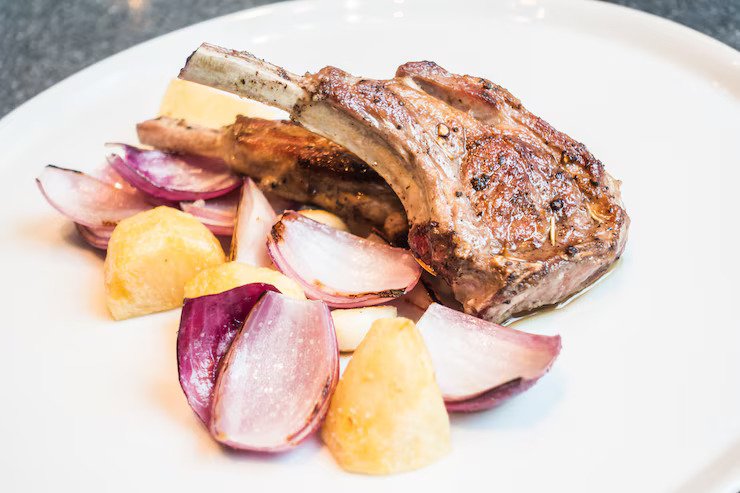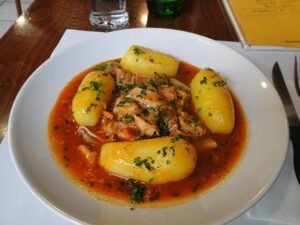In the small yet culturally rich nation of Luxembourg, culinary traditions are as varied as its linguistic landscape. While the country boasts numerous dishes that reflect its unique blend of French, German, and Belgian influences, one particular specialty stands out due to its rich smoky flavor and regional roots that make it the national specialty. This dish, known locally as Judd mat Gaardebounen, is a true embodiment of Luxembourgish gastronomy, celebrated not only for its taste but also for its cultural significance.
Judd mat Gaardebounen is a hearty dish featuring smoked pork collar, accompanied by broad beans, and often served with boiled potatoes. The preparation of this dish is a labor of love, involving a meticulous process that starts with marinating the pork in a brine of spices and herbs, which enhances its deep, smoky notes. This is followed by a slow cooking process that ensures the meat remains tender and flavorful. The magic of this dish lies in the contrast between the robust, savory pork and the fresh, slightly sweet flavor of the broad beans, which are typically cooked with a touch of cream and savory herbs.
Luxembourg’s culinary experts recommend pairing Judd mat Gaardebounen with a glass of local white wine, such as an Auxerrois or Riesling, which complements the dish’s rich flavors. The wine’s acidity cuts through the smoky richness of the pork, while its fruit-forward notes enhance the subtle sweetness of the beans. For those seeking an authentic Luxembourgish experience, sampling this dish during the annual Eimaischen festival, held every Easter Monday, is highly recommended. During this time, the streets of Luxembourg City come alive with traditional music, dance, and of course, the irresistible aroma of Judd mat Gaardebounen being prepared by skilled local chefs.
For culinary enthusiasts eager to try their hand at creating this national specialty, it is essential to source high-quality ingredients. The pork should ideally be sourced from local producers known for their traditional smoking techniques, while fresh, seasonal broad beans will ensure the dish stays true to its roots. With its rich history and unforgettable taste, Judd mat Gaardebounen not only satisfies the palate but also provides a unique insight into the cultural tapestry of Luxembourg. This dish remains a testament to the country’s culinary prowess and its ability to bring together diverse flavors in perfect harmony.
What is Luxembourg Best Dish?
In the rich tapestry of Luxembourg’s culinary heritage, few dishes stand out as prominently as Judd mat Gaardebounen. This traditional offering is a testament to the country’s unique blend of Germanic and French influences, which seamlessly merge to create flavors that are both robust and comforting. At its core, Judd mat Gaardebounen is a dish centered around smoked pork collar, a cut known for its tenderness and depth of flavor. The pork is meticulously cooked with broad beans, known locally as Gaardebounen, and a carefully curated selection of spices that enhance its natural savoriness.
The preparation of Judd mat Gaardebounen is an art form in itself, requiring patience and precision. The smoked pork collar is initially boiled to achieve perfect tenderness before being combined with the broad beans. This process allows the beans to absorb the rich, smoky flavors of the meat while still retaining a slight bite. The dish is characteristically served with boiled potatoes, which act as the perfect neutral counterpart to the intense flavors of the pork and beans, providing a balanced dining experience.
While this dish is hearty and satisfying, it is the nuanced use of spices that truly elevates it to an iconic status. Subtle notes of bay leaf, thyme, and peppercorns bring an aromatic complexity that complements the earthy beans and savory pork. This combination of textures and flavors is what makes Judd mat Gaardebounen a staple in Luxembourgian cuisine, cherished by locals and visitors alike.
For those seeking to experience the authentic taste of Luxembourg, sampling Judd mat Gaardebounen is a must. Whether enjoyed at a local bistro or prepared in a family kitchen, this dish offers a genuine taste of the country’s culinary traditions. Its enduring popularity is a reflection of its ability to bring people together over a shared appreciation for simple, yet exquisitely prepared, ingredients.
Exploring the Rich Culinary Heritage of Luxembourg
Luxembourg, a small yet culturally rich nation, boasts a culinary scene that reflects its diverse influences and historical ties. While many dishes have captured the attention of locals and visitors alike, one stands out for its unique blend of flavors and historical significance: the ‘Judd mat Gaardebounen.’ This dish, often hailed as Luxembourg’s national specialty, integrates the hearty taste of smoked pork with the freshness of broad beans, creating a harmonious balance that is both satisfying and deeply rooted in the region’s culinary traditions.
The secret to the popularity of Judd mat Gaardebounen lies in its rich smoky flavor and regional roots. The pork used in this dish is typically neck or shoulder, which undergoes a meticulous process of curing and smoking, infusing it with a depth of taste that is quintessentially Luxembourgish. This is complemented by the beans, which are simmered to perfection, absorbing the flavors of the meat and the aromatic broth. The dish is often accompanied by potatoes or a crusty loaf of Luxembourgish bread, perfect for soaking up the savory juices.
Ingredients and Preparation
To prepare Judd mat Gaardebounen, one must start with high-quality smoked pork, preferably sourced from local butchers who adhere to traditional methods. The following ingredients are essential for an authentic experience:
- 1.5 kg of smoked pork neck or shoulder
- 500 g of fresh broad beans
- Onions, carrots, and leeks for the broth
- A bouquet garni of thyme and bay leaves
- Salt and pepper to taste
- Potatoes or bread for serving
The preparation involves slowly simmering the pork with the vegetables and herbs until tender, allowing the flavors to meld. The beans are added towards the end of the cooking process, ensuring they retain a slight bite. This dish is best enjoyed with a glass of Luxembourgish wine or a cold beer, making it a perfect meal for both festive occasions and casual gatherings.
Cultural Significance
Judd mat Gaardebounen is more than just a meal; it is a celebration of Luxembourg’s cultural tapestry. Its origins can be traced back to the rural traditions of the country, where resourcefulness and a reliance on locally available ingredients defined the local cuisine. Today, it symbolizes the pride of a nation that cherishes its heritage while embracing modern culinary trends. Whether enjoyed in a traditional bistro or prepared at home, this dish continues to be a testament to Luxembourg’s rich culinary history, inviting all who taste it to savor a piece of the nation’s soul.
Discovering the Unique Ingredients in Luxembourg’s Iconic Dishes
Luxembourg, a small yet culturally rich nation, offers a culinary scene that is as diverse as its history. At the center of its gastronomy are traditional dishes that boast unique ingredients, each contributing to the country’s distinctive flavors. Understanding these elements is essential to appreciating Luxembourg’s national culinary identity.
One cannot explore Luxembourg’s cuisine without mentioning Judd mat Gaardebounen, a dish that stands as a national specialty. Its rich smoky flavor and regional roots make it the national specialty. The centerpiece of this dish is smoked pork collar known as Judd, a cut celebrated for its depth of flavor. This smoked meat is often paired with broad beans, a staple ingredient in Luxembourgish kitchens, offering a hearty complement that brings out the meat’s savory notes.
Another noteworthy ingredient is the Quetsch, or damson plum, which frequently finds its way into both savory dishes and desserts. This plum variety is prized for its balance of sweetness and tartness, making it an ideal component in tarts and jams that are a staple of Luxembourgish pastry. The use of Quetsch in dishes highlights the region’s agrarian traditions, where local produce is celebrated.
The humble potato also plays a significant role in Luxembourg’s culinary repertoire. A key element in Gromperekichelcher, or potato fritters, this versatile tuber is grated, seasoned, and fried to golden perfection. The fritters are often enjoyed as a street food snack or served as an accompaniment to main courses, showcasing the adaptability and importance of the potato in Luxembourgish cuisine.
Luxembourg’s strategic location in Europe has also allowed for an infusion of neighboring culinary influences. Ingredients such as creamy French cheeses, spicy Belgian endives, and robust German sausages have all found a place in local dishes, creating a fusion of flavors that is distinctively Luxembourgish.
To experience the true essence of Luxembourg’s cuisine, one should seek out these ingredients and the dishes they create. Whether dining at a traditional eatery or exploring local markets, the flavors of Luxembourg promise a fascinating and delicious journey through its culinary landscape.
How Luxembourg’s Best Dish is Prepared in Authentic Kitchens
Luxembourg’s culinary landscape is deeply rooted in tradition, and its national specialty, the Judd mat Gaardebounen, is a testament to this heritage. Known for its rich smoky flavor and regional roots, this dish exemplifies the country’s gastronomic identity. To truly understand how Judd mat Gaardebounen is prepared, one must step into the authentic kitchens of Luxembourg, where generations of culinary wisdom are meticulously preserved.
The preparation of this iconic dish begins with the selection of quality ingredients, a crucial step that cannot be overlooked. The centerpiece of the dish, the smoked pork collar, requires careful sourcing from reputable local butchers who understand the significance of traditional smoking techniques. The meat is often brined with a mixture of salt, sugar, and spices, then smoked slowly over beech wood to infuse it with the characteristic smoky aroma that defines the dish.
Equally important are the fresh broad beans, or Gaardebounen, which are harvested at the peak of their season. These beans are shelled and blanched to preserve their vibrant green color and natural sweetness. In some kitchens, chefs add a touch of regional flair by including a hint of nutmeg or a dash of Luxembourgish white wine, enhancing the complexity of flavors.
The cooking process requires patience and precision. The pork collar is simmered gently, allowing it to become tender while retaining its distinctive texture. The broad beans are added towards the end of the cooking time, ensuring they remain al dente. For a harmonious balance of flavors, a sauce made from onions, carrots, and leeks is sometimes incorporated, providing a subtle sweetness that complements the savory richness of the pork.
Serving Judd mat Gaardebounen is an art in itself. It is traditionally accompanied by boiled potatoes, which absorb the flavorful juices of the dish. The meal is often presented with a selection of mustard or a tangy horseradish sauce, which offers a piquant contrast to the smoky and savory notes.
In Luxembourg, the preparation and enjoyment of Judd mat Gaardebounen is more than just a culinary experience; it is a celebration of cultural heritage and communal tradition. Each step in its preparation reflects the dedication to preserving the authentic flavors that make it a source of national pride.
Savoring the Experience: Where to Find Luxembourg’s Best Dish
In the charming culinary landscape of Luxembourg, one dish stands out as the quintessential national specialty, drawing locals and visitors alike with its rich smoky flavor and regional roots. This dish, known as ‘Judd mat Gaardebounen,’ is a succulent smoked pork neck served with broad beans and a creamy sauce that ties the meal together into a harmonious blend of tastes and textures. To truly appreciate this culinary masterpiece, one must venture into the heart of Luxembourg’s vibrant dining scene, where tradition meets innovation in remarkable ways.
For a taste of authenticity, head to the historic district of Grund, where traditional eateries offer an inviting atmosphere and a menu steeped in Luxembourgish heritage. Here, restaurants such as ‘Am Tiirmschen’ serve up Judd mat Gaardebounen with a dedication to preserving the time-honored techniques that elevate this dish to its iconic status. The smoky aroma of the pork, slow-cooked to perfection, is complemented by the earthiness of the fresh broad beans, often sourced from local farms. The accompanying sauce, a delicate balance of cream and mustard, enhances the dish’s complexity without overpowering its inherent flavors.
For those seeking a modern twist on this classic dish, the bustling quarter of Kirchberg offers a variety of contemporary dining options. Establishments like ‘La Distillerie’ at the Chateau de Bourglinster infuse traditional Luxembourgish ingredients with international influences, presenting Judd mat Gaardebounen in innovative formats that surprise and delight. These reinterpretations may include unexpected elements such as truffle oil or a side of artisanal bread, providing a fresh perspective on the beloved dish while maintaining its connection to regional roots.
Another noteworthy destination is the picturesque Moselle Valley, where the scenic backdrop of vineyards offers a perfect setting to enjoy this national treasure. Many local wineries pair Judd mat Gaardebounen with their finest wines, enhancing the dish’s smoky undertones with the crisp notes of a Luxembourgish Riesling or Pinot Gris. This harmonious pairing not only elevates the dining experience but also pays homage to the region’s rich viticultural heritage.
Whether enjoyed in a traditional setting or with a modern flair, the experience of savoring Judd mat Gaardebounen is a culinary journey through Luxembourg’s cultural tapestry. Its rich smoky flavor and regional roots make it the national specialty, inviting all who taste it to explore the depth of Luxembourg’s gastronomic offerings. From the historic streets of Grund to the rolling hills of the Moselle Valley, this dish can be found at the intersection of tradition and innovation, a testament to the enduring appeal of Luxembourgish cuisine.










